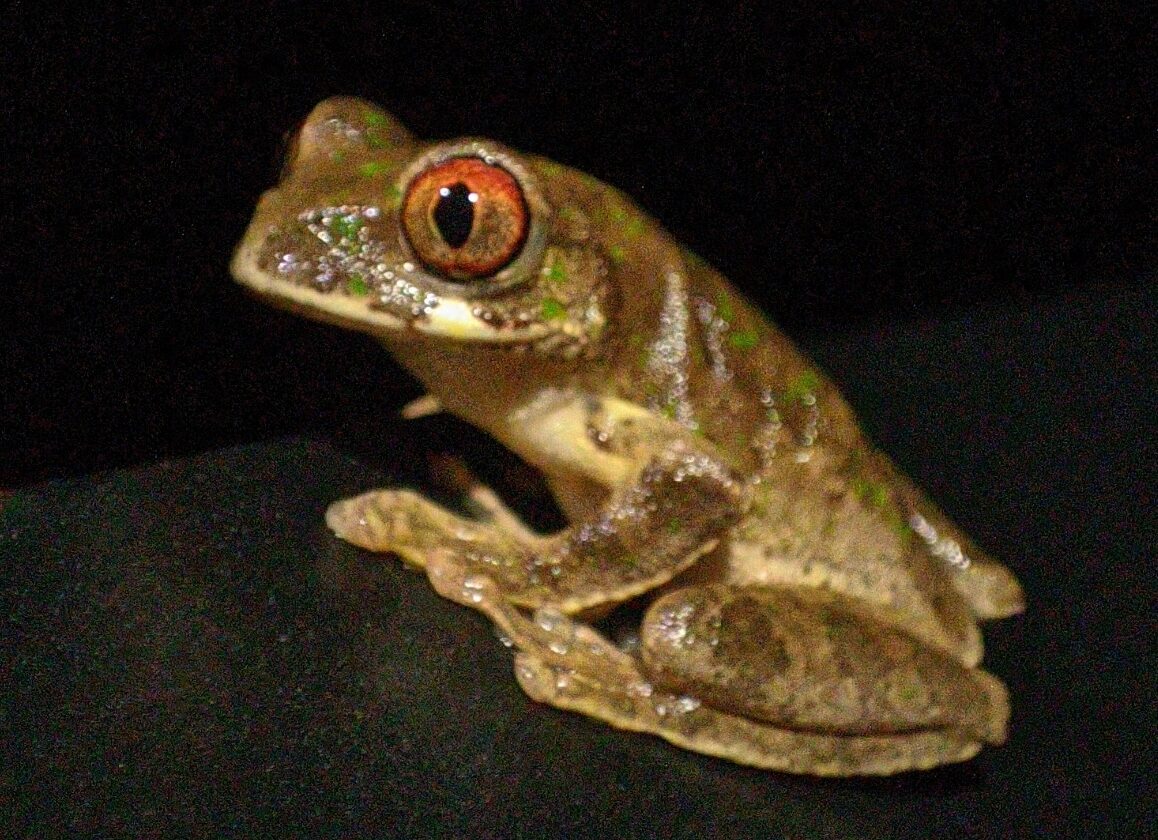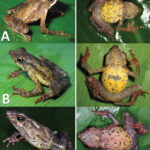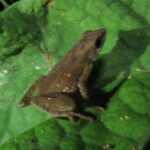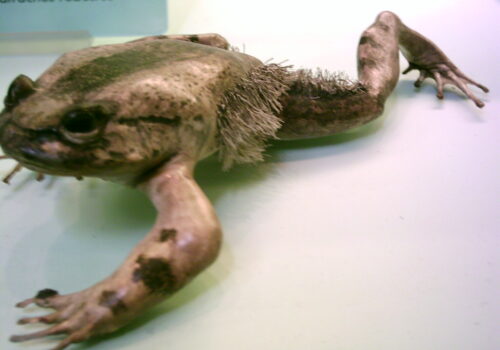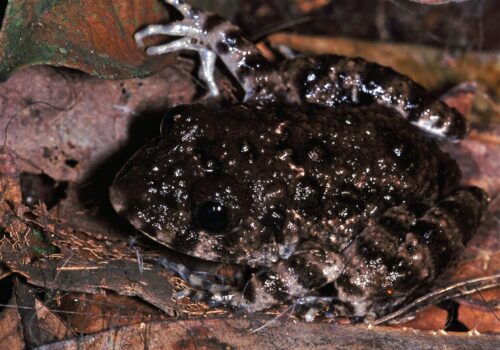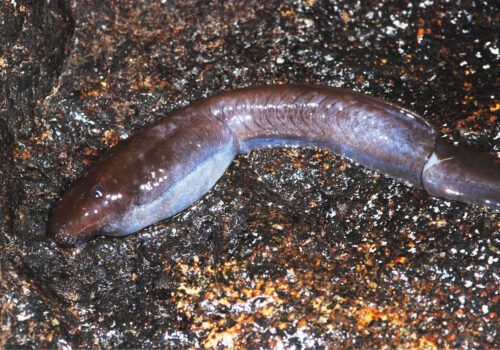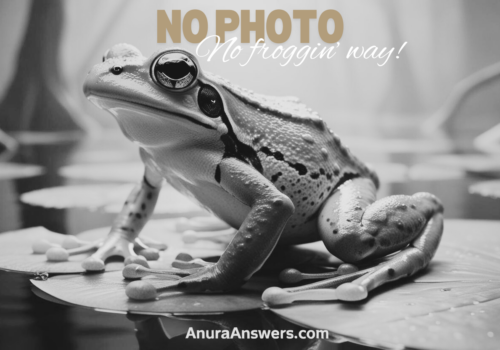- Leptopelis Karissimbensis: Unveiling the Hidden Jewel of Africa's Highland Forests
- Taxonomy and Classification
- Natural Habitat: The Mist-Cloaked Highlands of Central Africa
- Physical Characteristics: An Aesthetic Wonder of Amphibian Adaptation
- Behavior and Life Cycle: Thriving Among the Mist and Rain
- Ecological Role: Guardians of Forest Integrity
- Threats and Conservation Status: Navigating Troubled Forest Waters
- Cultural and Scientific Significance: A Frog Linking Ecosystem and Community
- Conclusion: Embracing an Enchanting Highland Guardian
Leptopelis Karissimbensis: Unveiling the Hidden Jewel of Africa’s Highland Forests#
Hidden amidst the misty forests of Central Africa’s towering mountain ranges, a small yet captivating amphibian resides in quiet secrecy. Leptopelis karissimbensis, commonly known as the Karisimbi Tree Frog, inhabits the moist, lush montane forests of Central Africa, thriving at altitudes where few amphibians can survive. Named after the majestic Mount Karisimbi—a dormant volcano in Rwanda’s Virunga Mountains—this species is uniquely adapted to life among mists and mosses, exhibiting fascinating morphological traits and behaviors that vividly demonstrate nature’s astounding adaptability.
This elusive amphibian species offers far more than charm and beauty. As a vital indicator within its ecosystem, Leptopelis karissimbensis serves as a barometer of environmental health, while also contributing significantly to biodiversity. Join us as we venture deep into the hidden realms of Karisimbi’s cloud-covered forests, unveiling the life story, ecological significance, and precarious conservation journey of this intriguing frog species.
Taxonomy and Classification#
Classified within the family Arthroleptidae, the Karisimbi Tree Frog (Leptopelis karissimbensis) stands firmly as part of the diverse African genus Leptopelis. This genus is renowned for its astonishing variability—in color, size, vocalizations, and behaviors—and spans a wide geographic distribution across Sub-Saharan Africa. The genus name “Leptopelis” translates roughly to “slender pelvis,” referencing the distinctive physique characteristic within this amphibian group.
Established scientifically in 1942, Leptopelis karissimbensis was recognized as a unique species due to its distinct genetics, specialized morphology, and restricted geographical range. Although morphological similarities exist between L. karissimbensis and other sympatric Leptopelis species, detailed genetic analyses firmly recognize it as a distinct evolutionary lineage, adapted narrowly to its specialized high-altitude habitat.
Natural Habitat: The Mist-Cloaked Highlands of Central Africa#
Leptopelis karissimbensis exclusively occupies the montane forest ecosystems spanning Rwanda, Democratic Republic of Congo, Uganda, and parts of neighboring Burundi. The species’ geographic range is primarily centered around the Virunga Massifs—these volcanic mountain ranges displaying astonishing altitudes over 2500 meters. Amidst dense vegetation, rich moss-covered trees, ferns, orchids, and countless perennial water features, this finicky frog has found refuge.
A Frog at Home Among the Clouds#
High-altitude montane forests are notably cool, humid, and perpetually shrouded in mist. These ethereal conditions are ideal for L. karissimbensis, whose survival depends upon maintained moisture levels for respiration and skin hydration. The species is primarily arboreal, spending most of its life selectively perched upon broad-leafed vegetation, mossy branches, and tree bark, capitalizing on the humidity-rich arboreal microhabitat.
Indeed, so particular are its habitat preferences, that sightings of this elusive creature often invoke call-to-ground expeditions into the montane undergrowth amidst dense fog and drizzle. Rain and fog not only enable the species’ respiratory function but encourage the insects and invertebrates it relies upon as food.
Physical Characteristics: An Aesthetic Wonder of Amphibian Adaptation#
The Karisimbi Tree Frog is modest in size, ranging approximately from 35 to 50 millimeters in body length, but its modest stature hides its impressive adaptations. Its coloration is subtly spectacular: varying from gentle olive-green tones to deeper shades of green, grey, and mottled brown. This palette, resembling speckled leaves, lichens, and moist mosses, demonstrates nature’s artisanship in camouflage.
Clever Camouflage: Blending Seamlessly Into Forest Canopy#
This coloration functions superbly as camouflage, vital for ambush predation and predator avoidance alike. Cryptic patterns blend flawlessly into mosses and lichens, aiding the frog in evading predators like birds and snakes while simultaneously increasing predation efficiency upon prey.
The eyes of L. karissimbensis deserve special mention. Strikingly large, reflective, and vertically slit pupils adapted to low-light rainforest conditions aid vision during nocturnal hunts. Sticky pads on finger and toe tips support confident and agile movements as the frog deftly navigates through foliage, branches, and vertical surfaces with remarkable ease.
Behavior and Life Cycle: Thriving Among the Mist and Rain#
Leptopelis karissimbensis leads primarily nocturnal and twilight-active lifestyles, emerging with sunset to hunt insects and other invertebrates. Their diet consists of beetles, caterpillars, moths, spiders, and numerous other terrestrial and arboreal insects. Utilizing their formidable eyesight and keen reflexes, they engage in rapid ambush tactics, quickly darting their long adhesive tongues to secure their prey.
Echoes in the Highlands: Mating and Calls#
During the rainy season, the frogs descend closer to the forest floor to congregate near vernal pools and temporary streams. Males produce a distinctive melodic call—described by some field researchers as a soft, persistent trilling—that resonates gently amid the leaves, guiding females toward their chosen breeding sites.
After courtship, female frogs deposit gelatinous clutches of eggs suspended directly above shallow bodies of water or attached cleverly to vegetation overhanging puddles. At hatching, the tadpoles drop or wiggle actively into these freshwater pools, developing swiftly in environments rich in organic detritus. Tadpoles feed voraciously, undergoing swift metamorphosis from aquatic larvae into land-dwelling juveniles adept at climbing and thriving atop moist arboreal habitats.
Ecological Role: Guardians of Forest Integrity#
As critical components within their ecosystems, these frogs function both as predator and prey. By extensively controlling insect populations, they indirectly contribute to maintaining plant health—protecting vegetation from heavy infestation. Conversely, as prey assets to birds, snakes, mammals, and even larger amphibians, they represent vital energy pathways within montane food webs.
Additionally, Leptopelis karissimbensis serves as a critical indicator species. Due to its narrow habitat tolerance, population changes—declines or expansions—rapidly reflect shifts in environmental quality such as pollution, climate fluctuations, and habitat degradation. Thus, their survival and conservation bear direct implications for the general health and resilience of montane ecosystems.
Threats and Conservation Status: Navigating Troubled Forest Waters#
Despite the idyllic scenes outlined in cloud forests, human pressures have increasingly placed Leptopelis karissimbensis at risk. Habitat fragmentation and deforestation, driven by logging, agricultural encroachment, and human settlement expansion, have greatly reduced and isolated their populations.
Facing a Climate Crisis#
Climate change, notably evidenced by shifting rainfall patterns and rising temperature gradients, poses severe threats to these moisture-dependent frogs. Declining frequencies of mist and rainfall that support mosses and ferns could dismantle the fragile ecosystems carefully balanced over millennia. Currently assessed by the International Union for Conservation of Nature (IUCN) as Near Threatened, their population trends demand ongoing vigilance.
Conservation Actions Underway#
Encouragingly, several national parks and protected areas, including Virunga National Park (DRC) and Volcanoes National Park (Rwanda), have implemented active protection measures. These initiatives restrict human encroachment, promoting reforestation and extensive biodiversity monitoring programs aimed at comprehensive amphibian data collection. Continued international collaboration and wildlife management strategies that prioritize habitat conservation will remain crucial.
Cultural and Scientific Significance: A Frog Linking Ecosystem and Community#
Within indigenous cultures inhabiting the volcanic slopes and highland regions of Central Africa, amphibians often symbolize renewal and rebirth due to their profound ability to seamlessly transition between aquatic and terrestrial habitats. Though specific symbolism for Leptopelis karissimbensis is sparsely documented, local communities within the Virunga mountains respect and acknowledge the significance of biodiversity preservation.
Scientifically, the species serves as an excellent model organism aiding researchers in understanding high-altitude adaptation, amphibian life cycles, and ecological relationships within montane forests. Valuable research studies involving L. karissimbensis have informed policies related to biodiversity protection, climate change mitigation, and even medicine.
Conclusion: Embracing an Enchanting Highland Guardian#
The captivating world of Leptopelis karissimbensis provides crucial insight into the fragile yet richly complex ecosystems of highland rainforests. Protecting this unique amphibian translates directly into safeguarding entire natural habitats and biodiversity. Let us cherish, study, and protect this elegant frog, for in protecting them, we hold promises for a vibrant, thriving, and biologically diverse future.

